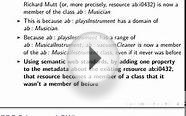Semantic language
- How meaning works in language:
The study of semantics looks at how meaning works in language, and because of this it often uses native speaker intuitions about the meaning of words and phrases to base research on. We all understand semantics already on a subconscious level, it's how we all understand each other when we speak.
- How the way in which words are put together creates meaning:
One of the things that semantics looks at, and is based on, is how the meaning of speech is not just derived from the meanings of the individual words all put together, as you can see from the example below.

[2]
The Principle of Compositionality says that the meaning of speech is the sum of the meanings of the individual words plus the way in which they are arranged into a structure.
- The relationships between words:
| Semantic relationship
|
Definition | Example |
| Synonymy | Words are synonymous/ synonyms when they can be used to mean the same thing (at least in some contexts - words are rarely fully identical in all contexts). | Begin and start,
Big and large, Youth and adolescent. |
| Antonyms | Words are antonyms of one another when they have opposite meanings (again, at least in some contexts). | Big and small,
Come and go, Boy and girl. |
| Polysemy | A word is polysemous when it has two or more related meanings. In this case the word takes one form but can be used to mean two different things. In the case of polysemy, these two meanings must be related in some way, and not be two completely unrelated meanings of the word. | Bright- shining and bright- intelligent. Mouse- animal and mouse- on a computer. |
| Homophony | Homophony is similar to polysemy in that it refers to a single form of word with two meanings, however a word is a homophone when the two meanings are entirely unrelated. | Bat- flying mammal and bat- equipment used in cricket.
Pen- writing instrument and pen- small cage. |
- The relationships between sentences:
| Semantic relationship
|
Definition | |
| Paraphrase | One relationship that two sentences can have with each other is being paraphrases of each other. This is a good example of how we all understand semantics already on some level because people can easily tell when a sentence is a paraphrase, because when two sentences are paraphrases of each other, even though the form is different you will understand the same meaning from them. Paraphrases have the same truth conditions; if one is true, the other must also be true. | 'The boys like the girls' and 'the girls are liked by the boys',
'John gave the book to Chris' and 'John gave Chris the book'. |
| Entailment | Entailment is a little more tricky than paraphrase in that the two sentences don't mean exactly the same thing, instead, when one sentence entails another, for the second sentence to be true, the first one must be true. There are two different types of entailment. | |
| Mutual enatilment
|
When each sentence entails the other, i.e. each sentence must be true for the other to be true. | 'John is married to Rachel' and 'Rachel is John's wife', |
You might also like



|
Mango Languages Mobile Application (Mango Languages)
|






 Wikipedia
Wikipedia